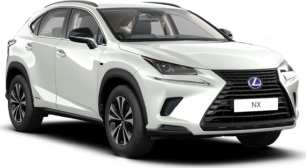Though distinctively attractive and obviously well built, the previous NX was quite small for a medium-sized SUV inside, with tight rear legroom.
It also had a nonsense mouse-operated multimedia controller that was fiddly, annoying and counter-intuitive to use.
Thankfully, the new-from-the-ground-up design has rectified both these issues in the latest version.
Now the NX is properly medium-sized, and so easier to get in and out of, as well as palpably roomier front and rear. Employing the RAV4’s TNGA architecture results in a lower and roomier cabin, that benefits all in terms of packaging.
Being the entry-level 250, you might not expect much in terms of interior presentation or style, but Lexus Australia’s product planners have been deft in specifying this grade to make it look luxurious and on-brand.
Body-hugging bolstered perforated leather front bucket seats, in our example finished in a black/cream hue with orange stitching, belie the base-grade reality of the 250. This scheme is also found on the centre console, armrest and door cards, lifting the ambience no end. It looks, feels and smells expensive in here.
The only thing that seems to be missing is a smartphone charger. That's part of a $3K option pack that also throws in a sunroof and foot-operated actuation for the electric tailgate. Not bad.
Then there’s the driving position, with an electrically-operated reach/height adjustable steering column and a multi-configurable seat to help find the right spot. All-round vision is also better than you might expect, no doubt helped out by huge exterior mirrors and a large reversing camera screen.
Typical Lexus-style classy digital instrumentation, directly ahead, are positioned in such a way that you’re not really aware of/missing the available head-up display in higher grades. Though it takes a quick amount of familiarisation, all the info there is ultimately clear and easy to take in.
The same applies to the now touch-only centre screen, which has a slick rich finish and tactility, and also encompasses the climate-control display.
Along with banishing the dreaded mouse pad, kudos to Lexus for also installing physical switches or buttons for the most-used items – audio volume, temperature setting, and front and rear window demisting.
These and the simplified sub-screen menus for navigation, wireless telephony/audio streaming, vehicle diagnoses and vehicle settings amongst other features, is quickly second-nature in their accessibility and operation. And the sound system quality is great too.
One of our very few complaints concerns the Apple CarPlay experience, which seems needlessly complicated to return to if you temporarily switch away from it to the NX’s native multimedia system. Confusing and distracting.
Never mind. There are minivan levels of practicality at work here, from the superb and easily manipulated ventilation system to the seemingly endless storage options, that include bottle holder capability in the doors, a clever lid operation for the huge centre console and properly engineered cupholders.
Lovely lush materials of satisfying quality are further plus points.
We’re also fans of the NX’s electric door opening system with a failsafe handle, meaning you can grasp the door handle inside or out and a solenoid activated by a press in of a thumb releases the door quickly and naturally in a single action; it feels… upmarket and ergonomic once accustomed to.
Accessing the back seat is easy due to the latest model’s larger proportions. Much of the same applies out back as the front seat area in terms of quality of finish and attention to detail. Sculptured and enveloping backrests (adjustable for two reclining positions), a well-padded cushion and more-than-sufficient space for two burly adults or three smaller people means this NX is more family friendly than the swoopy exterior styling suggests.
We’re also happy to find large people-facing air vents, two USB and a 12V outlets, one-touch electric windows with that premium-car soft close mechanism, overhead LED lights, grab handles, centre armrest with cupholders, map storage behind both front seats, coat hooks and good lines of vision further enhance the appealing and comfortable back seat environment. It feels like a Lexus should.
Further back than that, after releasing the electric tailgate via either an interior button or exterior switch, you’ll find that the boot has a fairly high loading lip, but then offsets this with a long, flat floor with matching levels of appropriate-quality finishes. Another 12V plug and two bag hooks are included, along with ample lighting and tie-down hooks. There’s also a hidden deep storage compartment underneath the floor, due to the discontinuation of a spare wheel (due to runflat tyres, remember).
Capacity is rated at a fairly ordinary 520 litres, extending to 1411L with the split/fold backrests folded. You’d expect a remote actuation for the latter like Mazda wagons have had for decades, but none is found at this price point.
Note there is no solid cargo cover either, just a flexible/flimsy fabric item that’s foldable and easily stored.
Overall, though, despite of its base positioning within the NX hierarchy, the 250's interior experience is in keeping with the brand's image.

